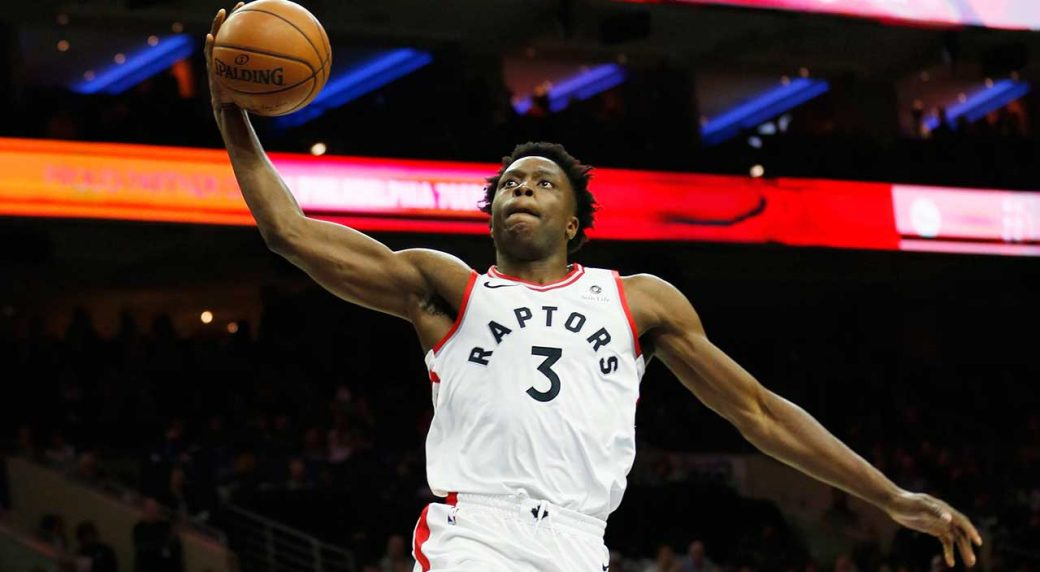The Raptors' Willingness to Try New Things is What Sets Them Apart

Toronto’s defensive execution and schemes were vital in the team’s championship run last season, and in the wake of major personnel changes the team is up to its old tricks.
Thursday night’s tilt with the Rockets was their latest foray into NBA unorthodoxy, as they whipped out the tried-and-true box-and-one as well as some triangle-and-two zone defense, though their most notable departure from convention came in the form of aggressive doubling as soon as James Harden got the ball, with the defense morphing into different shapes behind the pressure.
OG Anunoby was tasked with sticking to Harden all night, occasionally denying him so far out that the game was essentially played as a four-on-four for a few possessions. In the instances where Harden did get the ball, Fred VanVleet would run right over to force a pass. While that left the Rockets with four-on-three looks, it did accomplish Toronto’s main goal of preventing Harden from killing them singlehandedly.
The gambit was simple. Force the ball out of Harden’s hands and make literally any of the other Rockets do literally anything that they don’t usually do. Make PJ Tucker put it on the floor. Make Clint Capela do something other than throw down lobs. Make Ben McLemore play like a primary scorer.
With Anunoby and VanVleet playing the scheme diligently, Pascal Siakam, Kyle Lowry and Marc Gasol were left to do the scrambling. There’s a fantastic blend of athleticism, savvy and basketball IQ in there, and not many teams have the players to execute such a calculating defensive strategy.
You can see how effectively this staggered the Rockets early on, with
Harden basically out of frame after getting rid of the ball, none of
his teammates doing much to move, Capela forced to maneuver just a
little bit and Gasol picking up an easy steal.
Turning the Rockets into a team that would have to rely on ball movement would play into Toronto’s length and it resulted in 21 credited deflections for a team that averages 16.1 per game. Nick Nurse indicated that their internal count of the figure was much higher.
They were able to funnel things away from Harden, and got the other Rockets way more involved than usual. Tucker has averaged 41.8 touches per game this season and got 65 on Thursday. Austin Rivers went from 30.5 to 48. Danuel House went from 31.4 to 42. McLemore went from 26.0 to 49, though that’s skewed by his much-larger-than-average workload to an extent. Notably, Russell Westbrook, who was not on his A-Game, racked up a staggering 106 touches, well up from his average of 75.8 per night.
Although Harden was above his season average of 88.6 with 95 touches, most of those were passes. The Beard made 77 passes against the Raptors compared to his average of 49.6 per game.
And yet, the Raptors lost. The Rockets hit 22 3-pointers and crushed Toronto on the offensive glass. NBA players should be able to make hay out of uneven numbers eventually, even if some of Houston’s output looked a little on the fluky side. Full marks to Houston for making all of the necessary adjustments.
Even so, the Raptors had to know the perils of their choice going into the game. It was always possible that the Rockets would get hot. Maybe the Raptors felt it prudent to punt on rebounding since it was already an area of weakness to begin with if it meant slowing Harden. From Toronto’s perspective, the commitment to the plan was the most impressive part of the night.
In the most basic sense, no, the strategy didn’t “work,” as a loss is a loss. On a more nuanced level, any team would probably love to see James Harden limited to 23 points on 11 field goals and 17 free throws in over 40 minutes of play. The Raptors executed properly and were beaten by the shots that they were more comfortable conceding. It’s not always about the wins and losses, especially when you’re on solid ground in the standings, and in a lot of ways it was an illuminating experience. Even in a loss, the Raptors learned a lot about a new way that they can not only play, but execute at a high level, and make adjustments from there.
The real answer to the question of whether or not the strategy “worked” is another question: Would they play it out the same away next time? It’s hard to call for a total abandonment.
The NBA is very much a copycat league, which is what makes the Raptors’ defensive adventures so interesting. It’s also not lost that Nurse is deemed “innovative” for simply not doing the same thing that everyone else is. The schemes are ruthless and opponents’ secondary players should be taking them as a major affront, but it’s a simple, educated bet that other teams won’t play as well running their own secondary actions.
Nurse’s bag of tricks may be called “gimmicky,” but at the core these strategies are exceedingly simple. Most teams talk about taking away another team’s top options, and even if you account for Thursday as being the most ruthless of approaches, it’s clear that a lot of that ends up being more bark than bite. There are creative ways to attack that problem, but most teams trend more conservative in their decision making, and understandably so in a results-based business.
In a macro sense, these choices shouldn’t be notable at all considering what they’re designed to do. It’s not so much defensive genius as it is pragmatic and aggressive decision making. More than anything else, it’s just refreshing to see something different. Being willing to try new things has made the Raptors stick out like a sore thumb, and so far the team should be happy with the results.
Post a comment